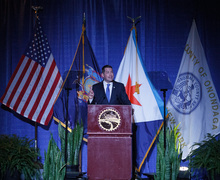Joe Girard III’s physical training built him into a starting point guard
Max Fruend | Staff Photographer
Joe Girard III's field-goal percentage (37.2), assists (2.3 per game) and rebounding (2.5 per game) have all increased in conference play.
Joe Girard III gained a step, dashed left and spun. A fade-away two-pointer got the crowd ready. On the next possession, a catch-and-shoot 3 from the same wing brought the fans to their feet. He leapt in front of the Carrier Dome stands after both shots, nodding his head along with the cheering.
It was Jan. 4, and Girard had been challenged, knocked down and stepped over by Notre Dame’s Prentiss Hubb. Watching miles away on television, Girard’s shooting coach Brian Travis knew what would follow. Girard walked across halfcourt, faked a pass left and pulled up.
“That’s the Joe I’m used to seeing,” Travis, 36, said. “That fierce, ‘I’m coming at you’ player.”
Six games, and five wins, later, Girard has more than settled into his role as the lone freshman starter in SU’s (13-7, 6-3 Atlantic Coast) lineup. His field-goal percentage (37.2), assists (2.3 per game) and rebounding (2.5 per game) outputs have increased in conference play. As Syracuse’s only consistent point guard option, he’s helped lead an offense that’s fourth in the ACC in offensive efficiency, per KenPom. And he’s done it by transforming his body and by playing a different role than he did in high school, where he became the best scorer in New York state history.
Girard’s early-season hype was compounded with sudden expectations of a starting job. They mirrored the expectations trailing behind his whole career. And he’s risen to the challenge. His production linked to the physical and mental training he underwent. Starting in high school with a new trainer and continuing through the summer of 2019 with Travis, Girard’s development into SU’s starting point guard occurred long before encountering Hubb.
“(Girard’s) going to make some mistakes,” SU head coach Jim Boeheim said earlier this season, “but he’s going to come after you.”
From the start, Girard showcased a well-rounded skill-set familiar to those who watched his Glens Falls tenure. He converted five of six 3s and pulled in five rebounds against Seattle in his third collegiate game. The growing pains would come when the competition level increased.
In the Barclays Center against Oklahoma State’s Isaac Likekele, Girard was pressed for most of the game and committed five turnovers. Likekele often forced Girard to dribble past him most of the court and hounded Girard. Saddled with a busted lip and a Quadrant-I loss, Girard said he had never faced a defender like the 6-foot-4 Cowboys guard.
It was one of the first times his physicality lacked at the Division-I level. Girard and his father identified this potential problem a few years ago and worked to correct it. After his ninth grade season, Girard met with JR Michael, a local trainer, for new techniques.

Roshan Fernandez| Asst. Digital Editor
Michael, then 28, played basketball recreationally after playing football at Hudson Valley Community College. He was assigned to Girard because his sports background allowed him to demonstrate each drill and explain its benefits. Girard’s father, Joe Jr., watched the first sessions and asked questions.
Initially, Michael took a baseline assessment of Girard’s physique. His weaknesses, Michael said, were in-line with that of many high school athletes: weaker core, lesser range of motion. Michael knew that Girard’s range would need to be expanded as his opponents eventually grew bigger and stronger.
They put Girard on a VertiMax, a resistance plyometrics board that works on a jumping and landing platform, to add a few inches to his vertical. They rotated in band work for lateral training, resistance bands to create muscle tension and fast-twitch. When Michael introduced Girard to Travis, a former high school teammate of Michael’s, they attacked the challenges together.
Hanging leg raises immediately followed by hanging leg tucks which were Girard’s least-favorite exercises, but eventually he was texting Michael videos of him completing them.
Girard needed to transform his body to recover quicker, as Glens Falls relied on him so heavily — he averaged nearly 50 points per game as a senior. Meanwhile, Girard cultivated some of the mobility skills he needed to be a better defender with Michael, something the Indians didn’t necessarily need but the Orange would a year later.
Between training sessions with Michael, Travis and Girard also competed in one-on-one shooting competitions. They played King of the Hill, joined five-on-fives and guarded each other, talking smack with each step. Travis knew Glens Falls’ system didn’t require Girard playing the tightest defense, so he challenged him some plays, coached him through others.
“He had to do everything every game for four years,’’ Boeheim said. “He’s used to having the whole world on his shoulders every game. He doesn’t have the whole world on his shoulders now.’’
As Girard eased into Syracuse’s lineup, opponents replicated Likekele’s full-court press strategy on Girard. A week later against Iowa, Girard dribbled it off his foot while a Hawkeye pressed him. Later in the contest, he directed fellow guard Brycen Goodine away from the press and brought it forward.
“Most freshmen can’t adapt like that,” Travis said. “He slows the game down. He controls the tempo.”
Michael and Travis saw Girard’s comfort level grow from afar, as Syracuse flipped close losses into season-shaping wins. He hung with Kihei Clark as the Virginia guard pressed. He committed three turnovers, but had small victories, too.
After gathering at midcourt, Girard faked a screen call by pointing to Clark’s left and then charging right before finding Marek Dolezaj for a dunk. He ran a two-man game with Elijah Hughes, alternating passes and 3-point makes.
“I’ve always been comfortable with the ball and I’m getting more comfortable with it as I’ve gotten experience,” Girard said post-UVA on Jan. 11. “.. You just gotta keep staying focused and get your team into the offense.”
Last Wednesday against Notre Dame, when he scored 15 points on three 3s, Girard passed his most-recent test — a rematch with Hubb played out over 40 full minutes — with two game-clinching free throws. Boeheim said freshman point guards haven’t done what Girard’s done this year. And by the time Girard checked his phone postgame, he had a text from Travis lighting up his phone:
“Great game. Keep working.”
Published on January 26, 2020 at 10:20 pm
Contact Nick: nialvare@syr.edu | @nick_a_alvarez





